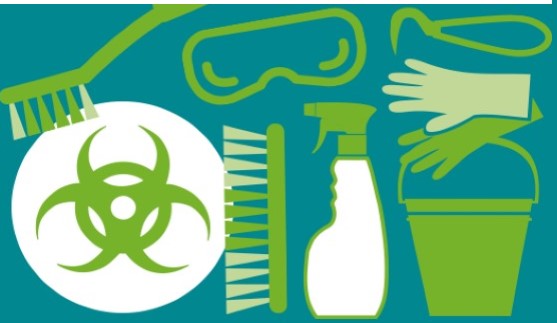Improve and Maintain Biosecurity
Each sovereign State is bound by international regulations to be responsible for maintaining its biosecurity and to strengthen security in all matters related to biological materials whether chemical, animal or plant and as well as associated facilities and activities including their storage and transport, to combat illicit trafficking of these materials and to have a rapid response plan for a biological attack, whether this be natural, intentional or accidental.
National Biosecurity Regime
Ireland’s authorities co-operate to provide efficient channeling of any relevant information, such as information on the degree of threat of a potential attack of a biological nature or other relevant information in accordance with national regulations protecting the use of that kind of information.
There is legislation in place to regulate biosecurity for facilities and associated activities on a national level in relation to the risk of illicit acts with biological materials which can have undesirable biological consequences. The biological materials, facilities and associated activities that are subject to a biosecurity regime are clearly defined. With government responsibilities allocated appropriately.
The biosecurity responsibilities are clearly stated of the organisations commissioned to transport these biological materials within Ireland, as well as the facilities that use them and the personnel working with them, with a biosecurity clearance process established. This include a system of compulsory inspections for regulations and existing or newly passed legislation, with sanctions imposed where necessary.
National Strategy to combat potential biological attacks
Ireland’s plan to combat potential biological attacks, whether natural or accidental has three phases which are continuously checked: Prevention, preparedness and reaction
Prevention
Risk evaluation and possible threat evaluation are based on prediction-oriented studies. The main factors for a threat of biological attack are ease of access and use, cost (economic, need for infrastructures, etc.) and the scale of the damage caused. The studies consider that the biological attack for which the study has been conducted, will occur in all likelihood which leads to the evaluation of an adequate prevention plan.
Preparedness
Evaluation of the risk of a biological attack needs three different kinds of analyses, not just from the state, but from those looking to improve and maintain biosecurity:
- evaluation of the magnitude
To correctly evaluate the risk of a biological attack, the possible group or groups of aggressors who may perpetrate that attack must be identified, together with their ideological foundation or motivation (political, religious, etc.) and their demands or claims, to assess the damage that might be caused.
- evaluation of the effect
This will depend on the different biological agent and the target, whether human, animal or plant and the impact of that damage. Usually terrorists harm whatever society is inclined to protect more or has the greatest level of sensitivity.
- evaluation of the vulnerability
Vulnerability is the susceptibility of society to a threat. This depends on the level of societal or economic damage that the potential attack would cause. Which is directly dependent on the consequence of the attack on citizens and institutions (emergency services to politics) which ensure the political, societal and economic stability of a country.
Vulnerability is the susceptibility of society to a threat. This depends on the level of societal or economic damage that the potential attack would cause. Which is directly dependent on the consequence of the attack on citizens and institutions (emergency services to politics) which ensure the political, societal and economic stability of a country.
Biosecurity Recommendations
Biosecurity regimes are to be updated regularly in relation to the evaluation of the threat, accessibility to biological agents and materials and more.
The person responsible for biosecurity and the security companies protecting or supervising the facility will also have to be empowered by authorities to have a biosecurity system that:
- Protects again a possible attack. Risk assess visiting trucks coming onto your property to collect produce, especially if they have already picked up produce from another property. A new staff risk assessment should be completed before you allow someone new into your production areas.
- That all the necessary means are available to counteract a threat. Ask all visitors to stay on established roads or tracks and monitor and register all visitors to the site to allow investigators to trace the origin and spread of a new pest incursion. Tools and equipment should be inspected and cleaned, particularly if they are borrowed or were purchased second hand. Collect run-off from wash areas in a sump or direct it away from production areas. Establish a plan for quarantining new animals. Change boots and coveralls after visiting animal sales barns and wash hands before working with your own animals. Require employees and visitors to wear clean coveralls and boots and consider stocking coveralls in small, medium and large sizes.
- The means to quickly detect any attempt of intrusion and to evaluate the conditions, circumstances and capacities of an attempted intrusion. Only permit access to production areas to personnel who need to be there.
- Access controls, including physical barriers. Limit the number of access points to your property, locking unused gates to control visitor access and manage high risk visitors such as those travelling from other farms or those who visit multiple properties each day. If visitors have previous contact with infected livestock, ask your veterinarian to confirm appropriate downtimes that must be observed.
- To share information with the state. Maintain animal movement records. List the contact information of buyers and sellers, the number and date livestock are moved onto your farm, their origin and premises identification number
- Accurate record keeping and list of registered persons with access to biological materials. Use a visitor log consistently. Require visitors to sign the log and include their name, full contact information, arrival and departure times and purpose of their visit. Make sure regular service providers, including veterinarians and feed truck drivers, sign the log, which is critical at times of traceback
- Contingency and emergency plans to respond to biological agents.
- Compliance to confidentiality criteria.
- Training of staff related to biosecurity. Hold induction sessions for seasonal workers to make sure they know about your on-farm biosecurity requirements.
- Clearance from the authorities that biosecurity measures are adequate



